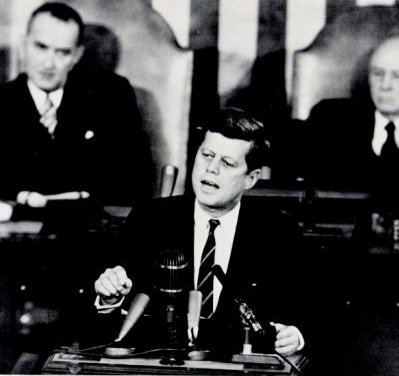
"I Believe We Should Go to the Moon"
By ROBERT R. GILRUTH

|
| Speaking to Congress and the Nation, President Kennedy said on May 25, 1961: "I believe that this nation should commit itself to achieving the goal, before this decade is out, of landing a man on the Moon and returning him safely to Earth. No single space project in this period will be more impressive to mankind, or more important in the long-range exploration of space; and none will be so difficult or expensive to accomplish." |
President Kennedy's statement, "Fly man to the Moon in this decade," was a beautiful definition of the task. There could be no misunderstanding as to just what was desired, and this clarity of purpose was one factor in the success of Apollo. By definition, it settled the old question of man versus instrument, and it provided a goal so difficult that new concepts, as well as new designs, would be required to accomplish it. Since the landing was geared to the decade of the sixties, the pace of the program was also defined, and a clear test of strength with the Soviets was implicit, if they chose to compete.
The President's decision came after a long series of Russian firsts. They were the first to orbit the Earth, and the first to send instruments to the Moon; only a month earlier, Yuri Gagarin had become the first man in space. Alan Shepard had followed Gagarin into space by only a few weeks to become the first American in space. This feat had given America the feeling that, with a major effort, we might close the gap with the Soviets. The public was ready and willing to expand the space effort, and Congress did not bat an eye at Webb's estimate that $20 to $40 billion could be required to go to the Moon. It was a popular decision, and the vote of the Congress on the Moon program was virtually unanimous.
But could it really be done? Flying man to the Moon required an enormous advance in the science of flight in a very short time. Even the concepts of manned spaceflight were only three years old, and voyaging in space over such vast distances was still just a dream. Rendezvous, docking, prolonged weightlessness, radiation, and the meteoroid hazard all involved problems of unknown dimensions. We would need giant new rockets burning high-energy hydrogen; a breakthrough in reliability; new methods of staging and handling; and the ability to launch on time, since going to the Moon required the accurate hitting of launch windows.
Man himself was a great unknown. At the time of the President's decision we had only Alan Shepard's brief 15 minutes of flight on which to base our knowledge. Could man really function on a two-week mission that would involve precise maneuvers, including retrofire into lunar orbit, backing down and landing on the Moon, lunar take-off, midcourse corrections on the way home and, finally, a high-speed reentry into Earth's atmosphere, performed with a precision so far unknown in vehicle guidance? We would have to do intensive work on spacesuit development, since flying to the Moon would be unthinkable without giving astronauts the capability of exploring the Moon on foot, and perhaps later in some roving vehicle. These men would have to be trained in the complex problems of flying and navigating in space, and we would need a cadre of men with space experience before setting out on such a voyage.
On the spacecraft side, we felt that the concepts already under trial in Project Mercury would be applicable for the command and service module, but we would need new sources of onboard power such as the fuel cell. The landing on the Moon would require precision guidance, as well as good visibility from the cabin for the astronauts, and a graduated control of rocket thrust heretofore undeveloped. The state of the art in tracking and communication would be severely tested. Precision navigation techniques using inertial systems would be necessary, and high-speed computing for solving complex navigation problems involving the celestial mechanics of three-body systems. The mass ratios involved in the spacecraft, particularly the lunar lander, would require the ultimate in materials. Safety factors would have to be stretched in order to give the low structural weights required. And in the spacecraft, as well as the launch vehicle, new orders of reliability would be required for so long a mission so far from home.
The Moon itself was a great unknown. Its surface, its mass distribution, and whether the lunar soil would be firm enough to support a landing craft were all open to conjecture. Finally, a master plan had to be evolved. The launch site had to be selected, roles and missions of government centers had to be determined, and a choice had to be made between the various concepts of how to go to the Moon, whether to use Earth-orbit rendezvous, direct ascent, or the most controversial of all, lunar-orbit rendezvous. A government team had to be built that, working closely together with leaders of industry, would manage the development and production of the launch vehicles, the spacecraft, and facilities for tests and operations. Not only would all these things have to be done in the short time available, but many would have to be worked out at the beginning, during what I have called "the year of decisions."
| Next |